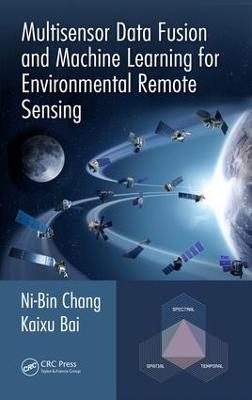
Multisensor Data Fusion and Machine Learning for Environmental Remote Sensing
Crc Press Inc (Verlag)
978-1-4987-7433-8 (ISBN)
In the last few years the scientific community has realized that obtaining a better understanding of interactions between natural systems and the man-made environment across different scales demands more research efforts in remote sensing. An integrated Earth system observatory that merges surface-based, air-borne, space-borne, and even underground sensors with comprehensive and predictive capabilities indicates promise for revolutionizing the study of global water, energy, and carbon cycles as well as land use and land cover changes.
The aim of this book is to present a suite of relevant concepts, tools, and methods of integrated multisensor data fusion and machine learning technologies to promote environmental sustainability. The process of machine learning for intelligent feature extraction consists of regular, deep, and fast learning algorithms. The niche for integrating data fusion and machine learning for remote sensing rests upon the creation of a new scientific architecture in remote sensing science that is designed to support numerical as well as symbolic feature extraction managed by several cognitively oriented machine learning tasks at finer scales. By grouping a suite of satellites with similar nature in platform design, data merging may come to help for cloudy pixel reconstruction over the space domain or concatenation of time series images over the time domain, or even both simultaneously.
Organized in 5 parts, from Fundamental Principles of Remote Sensing; Feature Extraction for Remote Sensing; Image and Data Fusion for Remote Sensing; Integrated Data Merging, Data Reconstruction, Data Fusion, and Machine Learning; to Remote Sensing for Environmental Decision Analysis, the book will be a useful reference for graduate students, academic scholars, and working professionals who are involved in the study of Earth systems and the environment for a sustainable future. The new knowledge in this book can be applied successfully in many areas of environmental science and engineering.
Ni-Bin Chang is currently a professor with the Civil, Environmental, and Construction Engineering Department at the University of Central Florida. He has authored and coauthored over 230 peer-reviewed journal articles, seven books and 220 conference papers. He is a Fellow of the Royal Society of Chemistry (F.RSC) in the United Kingdom (July, 2015), the International Society of Optics and Photonics (F.SPIE) (Dec., 2014), the American Association for the Advancement of Science (F.AAAS) (Feb., 2012), the American Society of Civil Engineers (F.ASCE) (April, 2009), and a Foreign Member of the European Academy of Sciences (M.EAS) (Nov., 2008). He is also a senior member of Institute of Electrical and Electronics Engineers (IEEE) (since 2012). During Aug. 2012 and Aug. 2014, Prof. Chang has served on a number of professional and government positions including the program director of the Hydrologic Sciences Program and Cyber-innovation Sustainability Science and Engineering Program at the National Science Foundation in the US. He is currently an editor-in-chief, associate editor, or editorial board member of over 30 professional
Introduction. Part I Fundamental Principles of Remote Sensing. Electromagnetic Radiation and Remote Sensing. Remote Sensing Sensors and Platforms. Image Processing Techniques in Remote Sensing. Part II Feature Extraction for Remote Sensing. Feature Extraction and Classification for Environmental Remote Sensing.Feature Extraction with Statistics and Decision Science Algorithms. Feature Extraction with Machine Learning and Data Mining Algorithms. Part III Image and Data Fusion for Remote Sensing. Principles and Practices of Data Fusion in Multisensor Remote Sensing for Environmental Monitoring. Major Techniques and Algorithms for Multisensor Data Fusion. System Design of Data Fusion and the Relevant Performance Evaluation Metrics. Part IV Integrated Data Merging, Data Reconstruction. Data Fusion, and Machine Learning. Cross-Mission Data Merging Methods and Algorithm. Cloudy Pixel Removal and Image Reconstruction. Integrated Data Fusion and Machine Learning for Intelligent Feature Extraction. Integrated Cross-Mission Data Merging, Fusion, and Machine Learning Algorithms Toward Better Environmental Surveillance. Part V Remote Sensing for Environmental Decision Analysis. Data Merging for Creating Long-Term Coherent Multisensor. Water Quality Monitoring in a Lake for Improving a Drinking Water Treatment Process. Monitoring Ecosystem Toxins in a Water Body for Sustainable Development of a Lake Watershed. Environmental Reconstruction of Watershed Vegetation Cover to Reflect the Impact of a Hurricane Event. Multisensor Data Merging and Reconstruction for Estimating PM Concentrations in a Metropolitan Region.Conclusions.
| Erscheinungsdatum | 12.04.2018 |
|---|---|
| Zusatzinfo | 69 Tables, black and white; 195 Illustrations, color; 40 Illustrations, black and white |
| Verlagsort | Bosa Roca |
| Sprache | englisch |
| Maße | 178 x 254 mm |
| Gewicht | 1292 g |
| Themenwelt | Informatik ► Grafik / Design ► Digitale Bildverarbeitung |
| Naturwissenschaften ► Geowissenschaften ► Geografie / Kartografie | |
| Technik ► Elektrotechnik / Energietechnik | |
| Technik ► Nachrichtentechnik | |
| Technik ► Umwelttechnik / Biotechnologie | |
| ISBN-10 | 1-4987-7433-4 / 1498774334 |
| ISBN-13 | 978-1-4987-7433-8 / 9781498774338 |
| Zustand | Neuware |
| Informationen gemäß Produktsicherheitsverordnung (GPSR) | |
| Haben Sie eine Frage zum Produkt? |
aus dem Bereich


